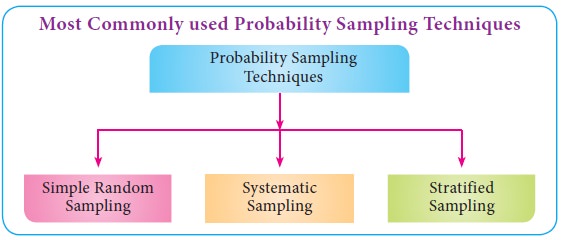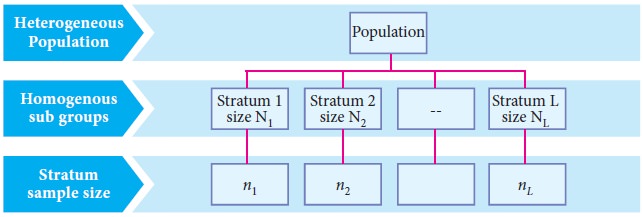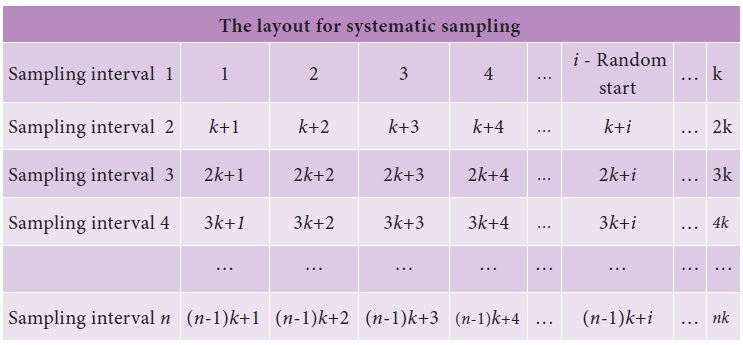Various Techniques, Merits, Limitations, Solved Example Problems, Applications - Probability sampling | 11th Statistics : Chapter 2 : Collection of Data and Sampling Methods
Chapter: 11th Statistics : Chapter 2 : Collection of Data and Sampling Methods
Probability sampling
Probability
sampling:
Probability sampling or random sampling involves a random
selection process to include a unit of the population in the sample. In random
sampling, all items have a positive probability of selection. Random sampling
techniques remove the personal bias of the investigators. Some of the important
methods of probability sampling are: Simple Random Sampling, Stratified Random
Sampling and Systematic Sampling.

Simple random sampling
This method selects a sample in such a way that each possible
sample to have an equal probability of being selected or each item in the
entire population to have an equal probability of being included in the sample.
The following are the methods of selecting a simple random sample.
(1) Lottery Method
Suppose that we have to select a random sample of size n from a
finite population of size N. First
assign numbers 1 to N to all the N units of the population. Then write numbers
1 to N on different identical slips
or cards so that a card is not distinguishable from another. They are folded
and mixed up in a drum or a box or a container. A blindfold selection is made.
The selected card may be replaced or may not be replaced before the next draw.
The Required numbers of slips are selected for the desired sample size under
any one of these methods forms a simple random sample. The selection of items
thus depends on chance.
Simple random sampling without
replacement (SRSWOR):
If the selected cards are not replaced before the next draw,
such a sampling is called without replacement.
Simple random sampling with
replacement (SRSWR):
If the selected cards are replaced before the next draw, such a
sampling is called sampling with replacement
Remark:
If the population size is large, this method is cumbersome. The alternative method is using of table of random numbers.
(2) Table of Random numbers
The easiest way to select a sample randomly is to use random
number tables. There are several tables of random numbers. Some of them are
·
Kendall and Smith random number table.
·
Tippet’s random number table.
·
Fishers and Yates random number table.
Method of using Random Number table.
In a given finite population, the method of selecting a random
sample from a random number table is given below:
The table contains different numbers consisting of 0, 1, 2,… ,9
and possesses the essential characteristics which ensures random sampling. A
part of the table is given as Appendix. Referring to this page, selection of a
random sample is explained by taking a finite population of size 100 units and
selecting a sample of 10 units. The steps to be followed are listed as under.
·
A list of all 100 units in the finite population is prepared and
each unit is assigned a serial number ranging from 00 to 99.
·
Any number in the table is chosen at random and it is the
starting point for selecting the sampling units.
·
From the starting point we can make a move on to the next number
either vertically, horizontally or diagonally.
·
Since our numbered population consists of two digits from 00 to
99 , we confine ourselves to reading only two digit numbers without omitting
any number that comes forward.
·
As we proceed, random numbers read from the table which are
above 99 are ignored and those numbers which are less than are equal to 99 are
recorded. This process is continued until we reach 10 such random numbers.
·
If sampling without replacement scheme is followed, a random
number once recorded appears again, the same is omitted and we move on to the
next number.
·
The 10 such selected random numbers are compared with the
labeled (numbered) population units and the corresponding units are selected to
get a simple random sample of size 10.
Example 2.1
Select a random sample of size 15 from the random number table
from a finite population of size 220.
Step 1 : Assign
serial numbers 00 to 219 to the 220 units of the population.
Step 2 : Since
the maximum digit is 3, select a three digit as starting point. Let the
starting point in the random number table is 066.(first two digits of the entry
in the 11th row and 4th column).
Step 3 : Continue
in the column downwards to select random numbers of size 15.
Step 4 : The
numbers chosen to have SRS are 066, 147, 119, 194, 093, 180, 092, 127, 211,
087, 002, 214, 176, 063 and 176. If we get any random number greater than 219,
then the multiple of 219 is to be subtracted from the selected number such that
the resultant value is less than 219.
Illustration:
Assume that the random is 892. But here, the maximum value
assigned for the population is 219 . Hence we select ’4’as the multiplier of
219. Then the random number correspond to 892 is 016. (See: 892 - 4 # 219 = 892 - 876 = 16 )
Case(1) : Under
SRSWR: Here the random sample is 066, 147, 119, 194, 093, 180, 092, 127, 211,
087, 002, 214, 176, 063 and 176.
Case(2): Under
SRSWOR: Here the random sample is 066, 147, 119, 194, 093, 180, 092, 127, 211,
087, 002, 214, 176, 063and 157.
Merits:
·
It is more representative of the universe.
·
It is free from personal bias and prejudices.
·
The
method is simple to use.
·
It
is to assess sampling error in the method.
Demerits:
·
If
the units are widely dispersed, the sample becomes unrepresentative.
·
The
method is not applicable when the units are heterogeneous in nature.
·
Units
selected may be too widely dispersed; thus, adherence to the whole sample may
be difficult. Remark: Simple random sampling is more suitable when the
population is homogeneous. If the population is heterogeneous we must go in for
stratified random sampling.
Stratified Random Sampling
In
Stratified random sampling, the heterogeneous population of size N
units is sub-divided into L homogeneous non overlapping sub
populations called Strata, the ith
stratum having Ni
units (i =1, 2, 3,…,L) such that N1+N2 +…. +NL = N.

sample
size being ni from ith stratum (i=1,
2,…,L) is independently taken by simple random sampling in such
way that n1+n2+… +nL = n. A sample obtained using this
procedure is called a stratified random sample.
To
determine the sample size for each stratum, there are two methods namely
proportionate allocation and optimum allocation. In proportionate allocation
sample size is determined as proportionate to stratum size. If the stratum size
large, that stratum will get more representation in the sample. If the stratum
size small, that stratum will get less representation in the sample. The sample
size for the ith stratum can be determined using the formula ni = (n/N)* Ni . The optimum allocation method
uses variation in the stratum and cost to determine the stratum sample size ni
.
Example 2.2
To
study about the introduction of NEET exam, the opinions are collected from 3
schools. The strength of the schools are 2000, 2500 and 4000. It is fixed that
the sample size is 170. Calculate the sample size for each school?
Solution
Here N = 2000 + 2500 + 4000 = 8500 and n = 170 then n1 = n2 = n13 =
?
N1 = 2000, N2 = 2500 , N3 = 4000
n1 = (n/N)× N1 = ( 170 / 8500 ) ×2000 = 40
n2 = (n/N)× N2 = ( 170 / 8500 ) × 2500 = 50
n3 = (n/N)× N3 = ( 170 / 8500 ) × 4000 = 80
Therefore
40 students from school 1, 50 students from school 2 and 80 students from
school 3, are to be selected using SRS to obtain the required stratified random
sample
The
main objective of stratification is to give a better cross-section of the
population for a higher degree of relative precision. The criteria used for
stratification are States, age and sex, academic ability, marital status etc,.
In many practical situations when it is difficult to stratify with respect to the
characteristic under study, administrative convenience may be considered as the
basis for stratification
Merits
·
It
provides a chance to study of all the sub-populations separately.
·
An
optimum size of the sample can be determined with a given cost, precision and
reliability.
·
It
is a more precise sample.
·
Representation
of sub groups in the population
·
Biases
reduced and greater precise.
Limitations
·
There
is a possibility of faulty stratification and hence the accuracy may be lost.
·
Proportionate
stratification requires accurate information on the proportion of population in
each stratum.
Systematic Sampling
In
systematic sampling, the population units are numbered from 1 to N
in ascending order. A sampling interval, denoted by k, is determined as k=N/n,
where n denotes the required sample size. Then n–1
such sampling intervals each consisting of k units will be formed. A number is
selected at random from the first sampling interval. Let it be number i where i
≤ k. This number is the random starting point for the whole
selection of the sample. The unit corresponding to i is the first unit in the sample.
The subsequent sampling units are the units in the following positions:
i, k +i, 2k +i, 3k + i , …, nk

Thus,
with selection of the first unit, the whole sample is selected automatically.
As the first unit could have been any of the k units, the technique will
generate k systematic samples with equal probability. If N is not an integral
multiple of n, then sizes of a few possible systematic samples may vary by one
unit.
Merits:
·
This
method is simple and convenient.
·
Less
time consuming.
·
It
can be used in infinite population.
Limitation:
·
Since
it is a quasi random sampling, the sample may not be a representative sample.
Example 2.3
Suppose
a systematic random sample of size n = 10 is needed from a population
of size N = 200, the sampling interval k=N/n=200/10=20.
The
first sampling interval consists of numbers 1 to 20. If the randomly selected
number (random starter) is 7, the systematic sample will consist units
corresponding to positions 7, 27,47,67,87,107,127,14 7,167,187.
Applications:
·
Systematic
sampling is preferably used when the information is to be collected from trees
in a highway, houses in blocks, etc,.
·
This
method is often used in industry, where an item is selected for testing from a
production line (say, every fifteenth item in the order of production) to
ensure that equipments are working satisfactorily.
·
This
technique could also be used in a sample survey for interviewing people. A
market researcher might select every 10th person who enters a particular store,
after selecting a person at random as a random start.
Related Topics